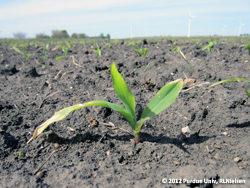29 April 2012
URL: http://www.kingcorn.org/news/articles.12/EarlyCornFearMonger-0430.html
Early-Planted Corn Developing Slowly
R.L. (Bob) Nielsen
Agronomy Dept., Purdue Univ.
West Lafayette, IN 47907-2054
Email address: rnielsen
at purdue.edu
Planting of the 2012 corn crop in Indiana got off to its earliest ever start. By April 8, an estimated 6 percent of the state's corn crop was already planted and that increased to 24% by the following week (USDA-NASS, 2012). The early rush to begin planting corn was fueled by the unusually warm late March temperatures, soil conditions that were favorable for field activities and.................................. memories of the near-record breaking delayed planting of the 2011 corn crop. So, how is that crop faring nearly a month after some of it was planted?
Probably the best way to describe the general condition of the crop to date is that it is behaving like a crop that was planted in late March and early April. Some of it has been damaged not once, but multiple times by frost events in the past few weeks. Some of it has been lethally damaged by temperatures that dipped into the mid- to high twenties (F). Some fields experienced windy periods of "sand blasting" in recent weeks that damaged corn seedlings. Many of the surviving fields are light green to almost yellow. Almost all of the fields are developing slowly relative to calendar time, but on schedule relative to the more typical cool April temperatures and the resulting slow accumulation of growing degree days (GDDs).
During the last half of March, the unusually warm air temperatures translated to unusually warm soil temperatures such that the average daily accumulation of soil temperature-based GDDs was in the neighborhood of 8 to 12 GDDs per day in central Indiana. Considering that typical soil temperature-based GDD accumulation per day in late March is nearly zero, the 2012 experience was very unusual. Temperatures cooled off in April to normal or even slightly below-normal and, thus, daily GDD accumulation has also been fairly normal for April.............. meaning not very many GDDs per day (less than 10).
Corn requires about 115 soil temperature-based GDDs to emerge. After emergence and until about leaf stage V10, leaf collar emergence occurs about every 80 GDDs. So, for example, corn planted Apr 4 in westcentral Indiana would emerge in 115 GDDs or about 14 days after planting this year. Then 80 GDDs later, the plants would be at leaf stage V1. In westcentral Indiana this year, those 80 GDDs accumulated over another 9 days.
Nothing about this is unusual, but growers should recognize that early-planted corn in Indiana sometimes faces challenges not just from typical frost or freeze events in April, but also due to the fact that crop development in April is typically slow from a calendar perspective. The importance of this simple fact is that corn seedlings rely on kernel reserves to sustain their growth until the plants transition from dependence on kernel reserves to dependence on nodal roots. This transition period typically occurs around the V3 stage of leaf development.
The longer it takes corn seedlings to reach and successfully transition to dependence on nodal roots, the greater the risk that stand establishment will not occur successfully in terms of achieving a uniformly healthy stand of corn by the time the crop is knee-high. Damage to the kernel or mesocotyl by soil-borne insects (e.g., wireworms) or disease prior to the successful transition to dependence on the nodal root system will stunt or kill seedlings. Repeated damage to above-ground plant tissue by recurring frost events takes its toll on the health of the seedlings prior to the transition period also.
Hopefully growers who chose to plant in late March or early April hedged their bets by also applying a healthy rate of starter fertilizer in a 2x2 placement band. The role of starter fertilizer is to assist young corn plants as they make the transition from kernel reserves to nodal roots during times when root development or function is compromised by less than optimum growing conditions.
The forecast return of warm weather this coming week will certainly be welcomed by these early-planted fields, as will the forecast rainfall in areas of the state that have been unseasonably dry throughout much of late March and April.
Related reading
Nielsen, RL (Bob). 2008. Use Thermal Time to Predict Leaf Stage Development in Corn. Corny News Network, Purdue Univ. online at http://www.kingcorn.org/news/timeless/VStagePrediction.html [URL accessed Apr 2012].
Nielsen, RL (Bob). 2010. Heat Unit Concepts Related to Corn Development. Corny News Network, Purdue Univ. online at http://www.kingcorn.org/news/timeless/HeatUnits.html [URL accessed Apr 2012].
Nielsen, RL (Bob). 2010. Root Development in Young Corn. Corny News Network, Purdue Univ. online at http://www.kingcorn.org/news/timeless/Roots.html [URL accessed Apr 2012].
USDA-NASS. 2012. Crop Progress. USDA National Ag Statistics Service. online at http://usda.mannlib.cornell.edu/MannUsda/viewDocumentInfo.do?documentID=1048 [URL accessed Apr 2012].


